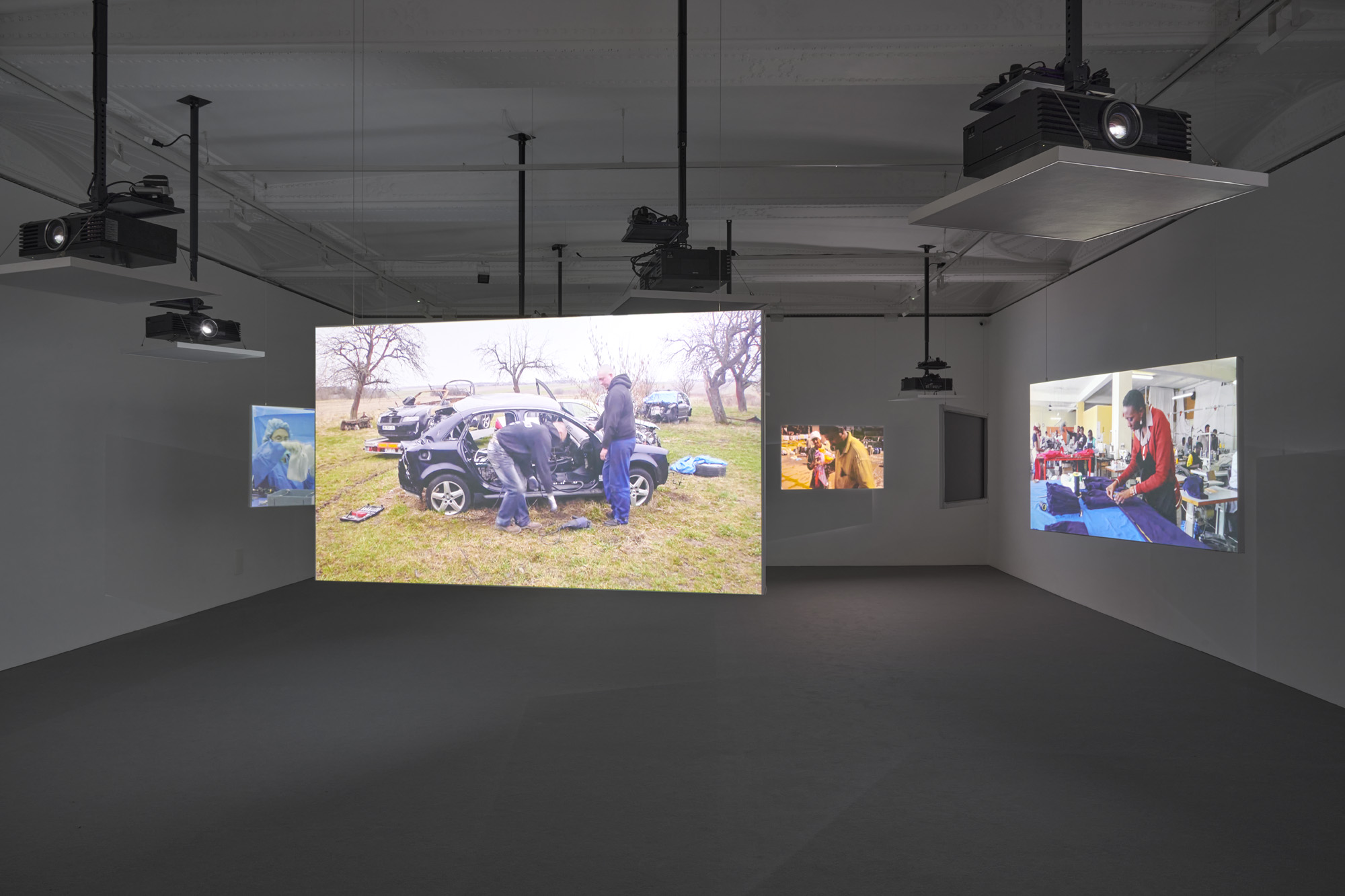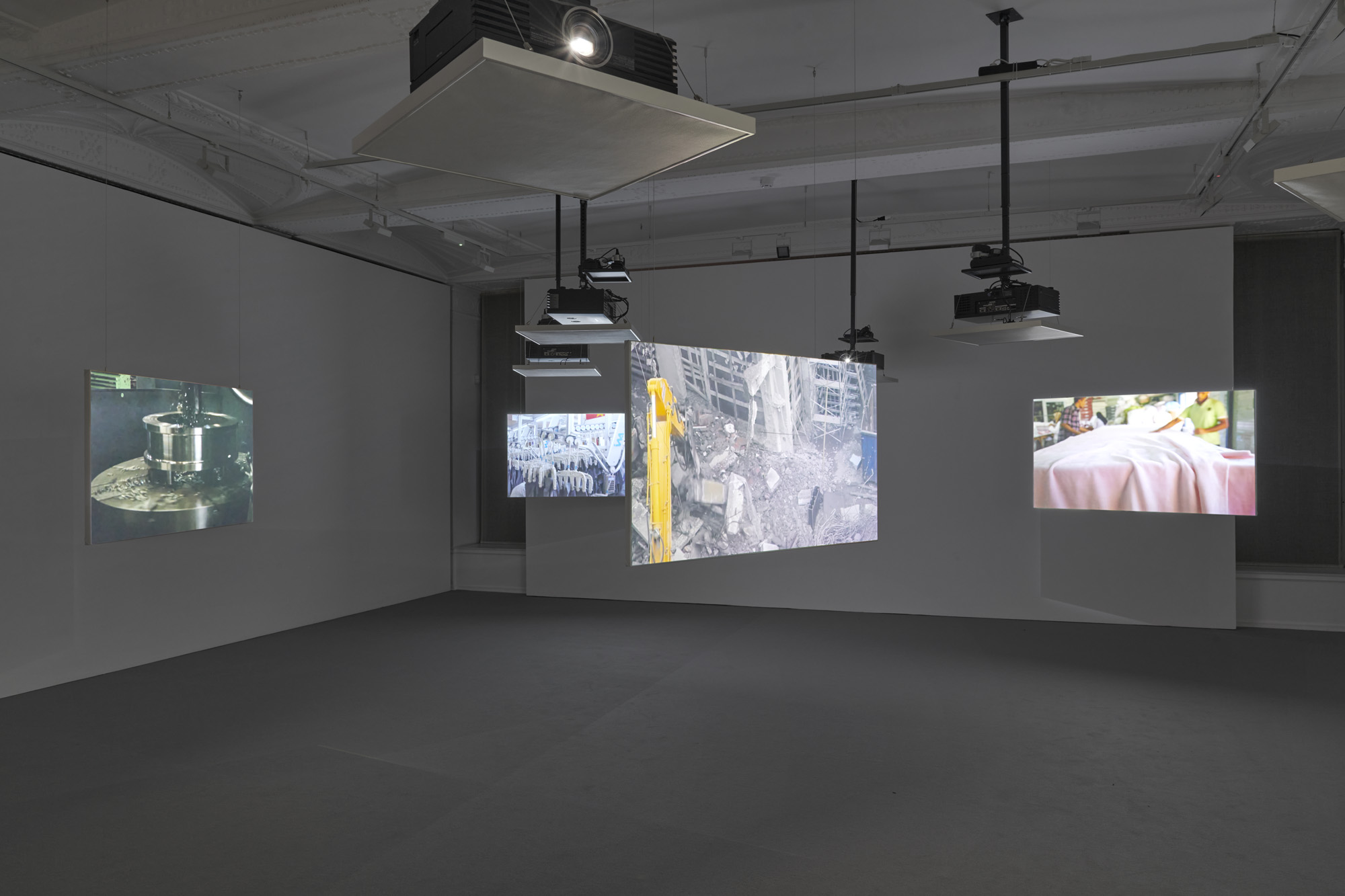On one screen, a Mexico City phone sex worker describes, in vivid detail, how to suck a lollipop to best imitate the sound of a blowjob. On another, a group of men in Bangalore apply hoof protectors to an ox which is lying on its side, all four legs bound together with rope. Faeces fall methodically from its anus while they go about their task, and once it has been accomplished, the ox’s legs are de-roped and it instantly bolts upright to its feet as the men reel back impulsively. I am watching Labour in a Single Shot, Harun Farocki and Antje Ehmann’s immensely sprawling work, at Ropac’s London gallery. It is currently showing in a dual exhibition with Hito Steyerl.
“Often labour is not only invisible but also unimaginable”
The piece is surely too big for most viewers to consume in totality. It brings together videos from all over the world, created by hundreds of directors, all showing a slice of labour in almost twenty different cities and regions. These are the result of workshops the artist and curator couple led together since 2011 (Farocki passed away in 2014), inviting videomakers to produce a 1- to 2-minute-long piece, which must not have any cuts. Labour is shown in all its forms, variously exhausting, boring, sweet and, in the case of one Ludz philosopher reading a book and stroking his forehead, hilariously muted.

At Ropac, the films are shown looping in a multi-screen installation. The first I encounter features the phone sex worker, describing her interactions in practical terms, and seeming to revel in the interviewer’s lack of experience in the area, as she corrects them on the most realistic sounds to make. Something that arises from many of the films, though only a couple of minutes long, is the repetitive nature of labour in its many forms, and the attitudes workers adopt to adapt to this. Viewers also bear witness to the combination of human and machine within many workspaces, with some videos trained only on the machine for a time, before a human operator steps into shot.
“Most of the work activities happen behind closed doors,” the artists have said of the work. “Often labour is not only invisible but also unimaginable. Therefore it is vital to undertake research, to open one’s eyes and to set oneself into motion. Where can we see which kinds of labour? What is hidden? What happens in the centre of a city, what occurs at the periphery? What is characteristic and what is unusual with regard to each city?”
As well as painting an important and potentially endless vision of labour around the world, this work also tells us a lot about filmmaking. Farocki began making video art in the 1960s, and was inspired by an array of practitioners and philosophers including Brecht and Godard. Filmmaking was political in his hands and often highly disciplined. Whether putting out a cigarette on his own flesh to symbolize the horrendous effects of napalm in the Vietnam War (1969’s video essay Inextinguishable Fire) or exploring the perverse loop of video games inspired by war which end up used as therapy for PTSD sufferers (Serious Games, 2009–10), the German artist fully embraced the visceral potential of filmmaking, and looked in many ways to channel its direct and regimented roots.
“We draw on the method of the earliest films, made at the end of the nineteenth century”
“Use video as if it were film,” he and Ehmann wrote in the concept statement for Labour in a Single Shot. “We draw on the method of the earliest films, made at the end of the nineteenth century (such as the Lumière brothers’ Workers Leaving the Lumière Factory and Arrival of a Train at La Ciotat) in order to regain something of their decisiveness. These early films, made in a single continuous shot, declared that every detail of the moving world is worth considering and capturing. They were forced by the immobile camera to have a fixed point of view whereas the documentary films of today often tend to indecisive cascades of shots.”
Each film exists in an online archive, and the very viewing of this entire collection would become a laboured task in itself. The fact that this massive undertaking offers only a tiny glimpse into the variegated labour undertaken every single day around the world, provides some sense of scale of the work carried out by billions of individuals throughout their lives, repeating tasks and providing services that keep our frenzied world ticking over. Watching some of these tasks being performed, it becomes apparent quite how little we think about the human activity that goes on behind the scenes.






